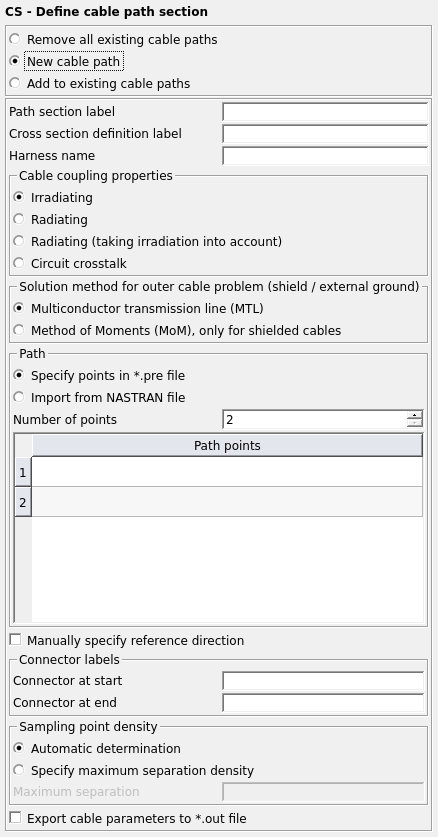CS Card
This card defines a cable path as well as the centre or reference location to which a cable cross section definition is applied.
On the Solve/Run tab, in the Cables group,
click the ![]() Cable path (CS)
icon.
Cable path (CS)
icon.

Figure 1. The CS - Define cable path section dialog.
Parameters:
- Remove all existing cable paths
- If checked, all previously defined cable paths are removed. All the other input parameters are ignored.
- New cable path
- Defines a new cable path. All previously defined cable paths are replaced.
- Add to existing cable paths
- An additional cable path is defined (that is the previously added cable paths will be kept).
- Path section label
- The label of the path section.
- Cross section definition label
- The label of the defined cross section to be applied to the path section.
- Harness name
- The label of the cable harness containing the cable path.
- Cable coupling properties
-
- Irradiating
- When this option is selected, only the effect of external fields coupling into a cable will be considered.
- Radiating
- When this option is selected, the effect of the currents radiating from the cables will be considered.
- Radiating (taking irradiation into account)
- When this option is selected, the combined effect of external fields coupling into a cable as well as the effect of currents radiating from the cable will be considered.
- Circuit crosstalk
- When this option is selected, the intra coupling between cables are considered (no external effects from fields or currents).
- Solution method for outer cable problem (shield / external ground)
-
- Multiconductor transmission line (MTL)
- When this option is selected, the model will be solved with the multiconductor transmission line which is also hybridised with MoM or the MLFMM. The cable path should be within of the conducting surface.
- Method of moments (MoM), only for shielded cables
- When this option is selected, the model will be solved with the MoM/MTL solver. Any arbitrary cable path may be defined.
- Path
-
- Specify points in *.pre file
- The points defining the cable path are specified in the .pre file. These points must have been defined previously with a DP card. The number of points defining the cable path section in the .pre file is set by the Number of points option. The Path points (as defined with a DP card) are specified to define the cable path section.
- Import from NASTRAN file
- The NASTRAN File name is required to import the cable path section. The NASTRAN segment property ID of the segments is also required to be able to import the cable path section.
- Manually specify reference direction
-
- X
- The X coordinate of the reference direction.
- Y
- The Y coordinate of the reference direction.
- Z
- The Z coordinate of cable the reference direction.
- Twist angle [degrees]
- The angle in degrees of the cable reference direction at the end of the cable path.
- Connector labels
- The start and end points of a cable path section are uniquely identified using the
Connector at start and Connector at end
labels. Currently cable path labels can be joined if all three of the following
conditions are satisfied:
- The labels share a node.
- The labels use the same cable connector.
- The labels use the same cable cross section definition.
Note: There is no support for splitting of cable sections or combining of cable sections using loads. - Sampling point density
- The cable path section will be subdivided into small segments for the computation of
the induced currents and voltages. The electric and magnetic field strengths will be
evaluated at each segment’s centroid. The setting Automatic
determination will choose the segment length automatically (which should
be adequate for most cases). If the maximum separation distance is specified, then this
value will override the automatic mechanism. This manual value will be scaled by any
active SF card.Note: This setting influences the accuracy and computation time of the computed result.
- Export cable parameters to *.out file
- When this item is checked the cable parameters such as inductance/capacitance matrices and transfer impedance/admittances are exported to the .out file.